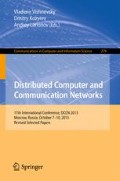Abstract
A controllable tandem queueing system consists of two nodes in tandem of the type \(M/M/n_i\) and a controller. Customers arrive to the controller, who allocates them between the nodes. After service completion at node 2 the controller can allocate the customer waiting at node 1 to node 2. With probability \(p\) after a service completion at node 1 a failure occurs. In this case the customer from node 1 joins node 2. With complement probability \(1-p\) the service completion at node 1 is successful. For the given cost structure we formulate an optimal allocation problem to minimize the long-run average cost per unit of time. Using dynamic-programming approach we show the existence of thresholds which divides the state-space into two contiguous regions where the optimal decision is to allocate the customers to node 1 or to node 2. Some monotonicity properties of the dynamic-programming value function are established.
This work was funded by the COMET K2 Center “Austrian Center of Competence in Mechatronics (ACCM)”, funded by the Austrian federal government, the federal state Upper Austria, and the scientific partners of the ACCM.
Access this chapter
Tax calculation will be finalised at checkout
Purchases are for personal use only
References
Altman, E.: Constrained Markov Decision Processes. Chapman and Hall, London (1999)
Aviv, Y., Federgruen, A.: The value-iteration method for countable state Markov decision processes. Oper. Res. Lett. 24(5), 223–234 (1999)
Efrosinin, D.: Analysis of the busy period in threshold control system. Autom. Remote Control 71(1), 87–104 (2010)
Farhadov, M.P., Petuchova, N.V., Efrosinin, D.V., Semenova, O.V.: Two-phase model with unbounded queues (in Russian). Problemy upravleniya 6, 53–58 (2010)
Farhadov, M.P., Petuchova, N.V., Efrosinin, D.V., Semenova, O.V.: Modeling of a hybrid call-center with self-services and threshold-based control (in Russian). Upravlenie Bolshimi Sistemami. Special issue 30.1 Network Models in Control, pp. 352–370. IPU RAS, Moscow (2010)
Ghoneim, H.A., Stidham, S.: Control of arrivals to two queues in series. Eur. J. Oper. Res. 21, 399–409 (1985)
Howard, R.: Dynamic Programming and Markov Processes. Wiley, New York (1960)
Beutler, F.J., Ross, K.W.: Optimal policies for controlled Markov chains with a constraint. J. Math. Anal. Appl. 112, 236–252 (1985)
Koole, G.: Convexity in tandem queues. Prob. Eng. Inf. Sci. 18(1), 13–31 (2004)
Liang, H.M., Kulkarni, V.G., et al.: Optimal routing control in retrial queues (chapter 14). In: Shanthikumar, J.G. (ed.) Applied Probability and Stochastic Processes, pp. 203–218. Kluwer Academic, New York (1999)
Piunovskiy, A.B.: Dynamic programming in a constrained Markov decision processes. Control Cybern. 35(3), 645–660 (2006)
Puterman, M.L.: Markov Decision Process: Discrete Stochastic Dynamic Programming. Wiley, New York (1994)
Rykov, V.: Monotone control of queueing systems with heterogeneous servers. QUESTA 37, 391–403 (2001)
Sennott, L.I.: Stochastic Dynamic Programming and the Control of Queueing Systems. Wiley, New York (1999)
Tijms, H.C.: Stochastic Models. An Algorithmic Approach. Wiley, New York (1994)
Veatch, M.N., Wein, L.M.: Monotone control of queueing networks. Queueing Syst. 12, 391–408 (1992)
Yang, R., Bhulai, S., Mei, R.: Optimal resource allocation for multiqueue systems with a shared server pool. Queueing Syst. 68, 133–163 (2011)
Yang, R., Bhulai, S., Mei, R.: Structural properties of the optimal resource allocation policy for single-queue systems. Ann. Oper. Res. 202, 211–233 (2013)
Author information
Authors and Affiliations
Corresponding author
Editor information
Editors and Affiliations
Rights and permissions
Copyright information
© 2014 Springer International Publishing Switzerland
About this paper
Cite this paper
Efrosinin, D., Farhadov, M., Kudubaeva, S. (2014). Performance Analysis and Monotone Control of a Tandem Queueing System. In: Vishnevsky, V., Kozyrev, D., Larionov, A. (eds) Distributed Computer and Communication Networks. DCCN 2013. Communications in Computer and Information Science, vol 279. Springer, Cham. https://doi.org/10.1007/978-3-319-05209-0_21
Download citation
DOI: https://doi.org/10.1007/978-3-319-05209-0_21
Publisher Name: Springer, Cham
Print ISBN: 978-3-319-05208-3
Online ISBN: 978-3-319-05209-0
eBook Packages: Computer ScienceComputer Science (R0)

